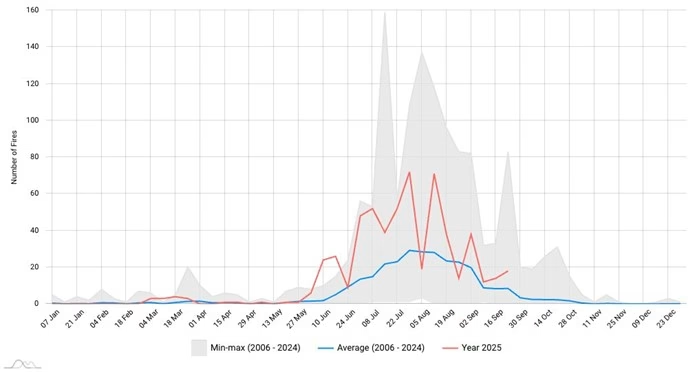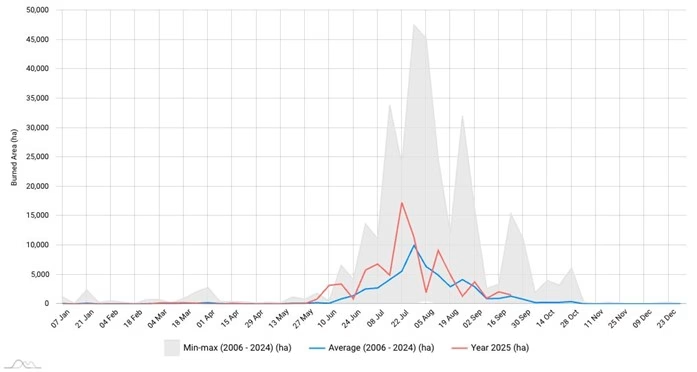In this scenario, wildfires represented a further piece of the mosaic. Summer 2025 was marked by meteorological conditions particularly favorable to ignition and spread of fires: high temperatures, prolonged drought and strong winds affected not only Italy, but the entire Mediterranean basin.
In particular, the temperature anomalies in June generated a corresponding anomaly in the earlier-than-average start of the fire season compared to the last 20 years, leading to a high number of fires, especially in Central-Southern regions and the major islands.

However, although meteorological conditions typical of July occurred a month early, there were no particularly large fires in terms of burned area. This was likely due to the lower susceptibility to fire of fine fuels, which were abundant thanks to rainfall in previous months but not yet fully senescent.

However, June anomalies anticipated vegetation stress, which in July led to a total burned area above the historical average but still far lower than the values recorded in summer 2021 and than historical maxima. Although temperature anomalies particularly affected the northern regions, the regions most affected by fires were in the South.
The high temperatures recorded in the North were almost always associated with high relative humidity, which further aggravated the impacts of the heatwave on human health but kept fuel moisture at rather high values, making them less susceptible to ignition and spread of fire. This did not occur in the southern regions.
In Calabria, the Regional Operations Room recorded 651 fires, down from 715 in 2024 and far lower than in 2021, when there were 1,409, thanks to the steady commitment to monitoring undertaken in recent years with the use of UAVs. However, the total burned area increased, from 4,700 hectares in 2024 to 5,000 in 2025. This was due to extreme meteorological conditions mainly affecting Basilicata, Calabria, Apulia and Sicily. These conditions were attributable to extremely dry strong winds which, in the last week of July, brought fuel moisture to values close to zero; winds reached 20 m/s with relative humidity below 10%. 1

Despite this period of extreme conditions which, in the past, has been associated with fires destroying thousands of hectares, the average burned area per fire was 7.53 hectares, a figure below the national average. Here too this is attributable to prompt suppression actions and improved organization.
Under extreme conditions, fires originating in agricultural areas spread to forests, a phenomenon observed particularly in the provinces of Cosenza and Crotone. Comparison with recent years confirms that, despite fluctuations, from 2022 to 2025 the burned areas remained contained, especially when compared with 2021 and 2017, which remain dramatic years with enormous areas destroyed by flames. This shows how a simple reading of fire statistics, if not related to actual danger conditions, does not fully highlight the impacts of strengthened prevention systems: from land management to the effectiveness of forecasting, warning and response systems.
- Data updated as of 31 August 2025. ↩︎
